I don’t normally give this space over to reviewing DVDs, but this new release—it came out on Tuesday, Sept. 23—is something of an historic event. It’s perhaps not quite the historic event it might have been—owing to a couple of truly unfortunate omissions—but as historic events in the realm of cinema go, I gotta say ‘tain’t bad. Well, in all candour, it’s really pretty damn phenomenal. A nicely encased three disc set containing the filmmaker’s Elgar (1962), The Debussy Film (1965), Always on Sunday (1965), Isadora Duncan: The Biggest Dancer in the World (1966), Dante’s Inferno (1967) and Song of Summer (1968) is certainly of no little cultural significance.
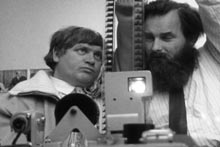
All too often, there’s a tendency to denigrate the work filmmakers do for television—the thought being that it’s somehow automatically inferior to theatrical film. I understand that. I even subscribe to it myself when dealing with television as a series concept. While it’s possible for a filmmaker to express something of himself onto an episode of a series, he’s locked into established characters and an overall approach. There’s no doubt that, say, Roy Ward Baker’s Too Many Christmas Trees (1965) and Sidney Hayers’ The Joker (1967) are superior episodes of the TV series The Avengers, both men are working within a format. Similarly, it’s hard not to argue that the true “author” of all seventeen episodes of The Prisoner (1967) is star Patrick McGoohan, even if he only directed some of the shows.
For filmmakers, series TV offer scant personal expression. This, however, doesn’t hold true when dealing with something like Ken Russell’s TV films. The ones made for the BBC between 1959 and 1970 do qualify as part of the BBC’s Monitor and later Omnibus art series, but they are otherwise unconnected, except that most of them are films on artists of one sort or another. The earliest ones can be classified as—often quirky—documentaries, but as they progress they become ever more complex biographical films quite capable of being viewed as stand-alone movies—or, more properly, as an integral part of the filmmaker’s oeuvre. To dismiss these films as inherently inferior to Russell’s theatrical films sells both the films and the filmmaker short.
As a result, the release of six of the films—spanning 1962 through 1968—on DVD should proved something of a revelation to cineastes who only (or even mostly) know Russell through his theatrical work. It’s possible to look at the TV films as formative, but this doesn’t quite work. Russell made two theatrical films—French Dressing (1963) and Billion Dollar Brain (1967)—during the same period, and if we extend the time frame to include (as the set does not) his last film for Omnibus, then Women in Love (1969) falls into this same period. The earlier films may qualify as formative, but the later ones are no more that than The Music Lovers (1970) is formative in relation to Mahler (1974). The best way to take them is simply as part and parcel of his overall filmography.
Elgar (1962). The earliest film in the set is, in many ways, the film that brought Russell to his first real acclaim. It was immensely popular in Great Britain—doing much to re-ignite interest in Sir Edward Elgar, who is arguably Britain’s greatest composer. It’s also the film that most fits the term “formative.” Compared to later films, Elgar is almost like a rough sketch—but what a sketch it is.

To appreciate the immensity of Russell’s accomplishment with this film, it’s necessary to understand the mindset of the BBC—and series mastermind Huw Wheldon—at the time it was made. When Russell was hired (to replace John Schlesinger, who had “defected” to the world of theatrical filmmaking), the programs were entirely documentary in nature and the approach was fairly straightforward, focusing on artists then working. But as time wore on, Russell started working on films about artists no longer living. (He once remarked that they “ran out of live artists.”) This raised the question of “dramatic recreations,” which Wheldon resisted in the belief that viewers would think they were watching the real people in archival footage. To get around this, Russell would slip in bits and pieces of new footage that did not directly depict the subjects of the films—finally getting permission to show the composer Sergei Prokofiev as a reflection in a pond (“a murky pond” by instuction) in Prokofiev (1961). This emboldened Russell to go a step—a large step—further with Elgar.
Convincing Wheldon that this ambitious film could only be undertaken with the use of recreated footage, Russell finally got his way—sort of. It was decreed that the actors portraying Elgar would not speak and would be seen mostly at a distance. Any speaking in the film came from Wheldon’s narration. Russell adhered to the non-speaking aspect of the agreement like a perfect gentleman, while cheating outrageously on just how much and how closely he viewed the actors playing Elgar. The approach to the characters as “figures in a landscape” is only partly honored, but apparently enough so to satisfy Wheldon. The results electrified the TV audience.
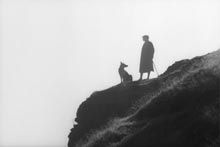
That Russell was sneakily coloring outside the lines with the film in a number of ways may account for its largely non-controversial nature in others. Russell does illustrate Elgar’s distaste for British imperialism and his outright loathing of noisy spectacle and the jingoistic words applied to the finale of his Coronation Ode (itself drawn from Pomp and Circumstance March no. 1) when it was made into “Land of Hope and Glory.” At the same time, no mention at all is made of Elgar’s unusually close relationship with his music publisher August Jaeger. In this regard, it was playing safe. (Ironically, when Russell revisted Elgar with his 2002 film Elgar: Fantasy of a Composer on a Bicycle he touched on this in a scene that was cut from the final version because it didn’t fit the rest of the film.) In other respects, however, Elgar wasn’t safe at all.
Looking at Elgar in any depth, it’s clearly rooted in the Catholicism of the composer and the filmmaker. Russell has said that all his films are very Catholic and while that’s a reasonable statement on a number of levels, this is the film that provides the most uncritical view of Catholicism. In some ways, it’s the most overtly mystical, too. Elgar is a film that is obsessed with threes—which is to say that it’s a film obsessed with the Holy Trinity. Variations on the number appear constantly throughout the film, built around three journeys by Elgar across the ridge of the Malvern Hills—as a boy on a pony, as a young man on a bicycle, as an old man in a car—set to the composer’s Introduction and Allegro for Strings. In addition to this, various objects—ranging from the three crosses of the crucifixion to three microscopes on a billiard table to three dogs to three loudspeakers to three stunt bi-planes—are arranged in threes throughout the film. Fascinating and poetically and thematically apt, this gives the film its shape and its thrust.
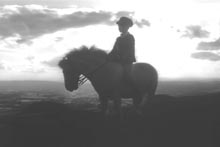
Additionally, Elgar announces Russell’s penchant for lush, romantic, evocative imagery—and, just as importantly, a playfulness of spirit. Both of these are central to all of Russell’s work from that day to this. If nothing else, the film carries a bold statement that the filmmaker has no intention of embalming either his subjects, or their works in a fog of phony, affected reverence. Russell is interested in both his characters and in what they did as living, breathing things—sometimes flawed, sometimes comical, but never less than alive. Take Elgar with these things in mind and you can see what a significant work it really is.
The Debussy Film (1965). The set skips over several films (why Bartok (1964) isn’t included is a mystery and it wouldn’t have killed them to add in the moody, satirical Lonely Shore made that same year) to get to The Debussy Film, one of the most ambitious and complex films from any period of the filmmaker’s career. When Russell saw the film for the first time in years around 2000, he immediately pronounced it “the best thing I ever did.” Now, that’s an assessment that ought not be taken at face value, since I’ve seen him make the same statement about Song of Summer (1968) and Lisztomania (1975) upon revisiting them. However, his enthusiasm isn’t hard to understand. Debussy is a breathtaking work.
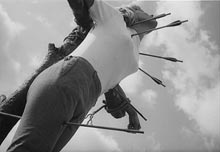
Here, Russell gets around both the budgetary restrictions of working for the BBC and any restrictions about using actors by presenting not a film about Debussy as such, but a film about making a film about Debussy. To this end, Russell brought in Vladek Sheybal to play his onscreen alter ego, the director bringing his impressions of Debussy to the screen. (Sheybal would undertake the exact same position in Russell’s 1971 feature The Boy Friend.) Another notable addition—a very notable one—lay in his casting of Oliver Reed as the actor playing Debussy (and, by extension, as Debussy), starting a personal and professional association that would last (with a time-out or two when their egos clashed) until Reed’s death.
The unusual structure of the film allowed Russell to explore not just the composer and his reaction to Debussy’s music, but his own approach to filmmaking and indeed the whole nature of art and how it both imitates life and is simultaneously a factor in shaping life. If that sounds complex, the film is even more so, since it mirrors Debussy’s life in the lives of those involved in making the film. While Debussy becomes romantically involved with Gaby Dupont (Annette Robinson), so too does the actor playing Debussy—and for that matter, so does the filmmaker fall prey to her charms. Moreover, the relationship of the actor and actress mirrors that of Debussy and Gaby, while the actor’s growing involvement with the character he’s portraying starts to show up the shallowness of the actress. The complexity of all this reaches a fever pitch in a remarkable scene that has the actors and director watching a stage performance that mirrors real life—theirs and Debussy’s—while intercutting footage of both stories. For sheer layering, Russell may have never quite topped this.
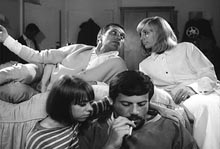
The matching of music—and Russell’s reaction to that music—to images is equally extraordinary. The procession scene depicting the filmmaker directing his vision of the music being heard on the soundtrack is remarkable in itself, as in fact is the whole film, but there’s something else at work here—something that there’s no trace of in Elgar. In The Debussy Film Russell is holding the artist accountable for the shortcomings of his life—for the often casual destructiveness of his behavior as it impacts those in his sphere. This aspect of Russell’s work would grow to the point of obsession—and would result in a major misunderstanding of the impetus behind his films. This examination of the responsibility of the artist for the actions of his life has often caused Russell’s detractors to accuse him of doing hatchet jobs on his subjects. The truth is somewhat different and it can be seen here.
The approach isn’t to denigrate the subject, but to present a more complete picture of the artist as a human being. The point isn’t to “get at” the artist, but to understand him—and, in the bargain, delve into the mystery of the act of artistic creation. Russell is looking into the factors—good and bad—that were necessary to create this art. At this point, the results are a kind of wonderment over the fact that these flawed human beings could possibly be responsible for all these wonderful things, and to accept the fact that a lot of people—including the artist—paid a heavy price to create them. As time goes on, this transforms into a reflective sense that it isn’t so much that they created these things despite their flaws, but actually because of them. Here, we have a work that in essence concludes that what remains of Debussy comes down to, “It seems he was a composer.”
Always on Sunday (1965). Russell’s film on the French primitive or naive painter Henri Rousseau came next and is included in the set. Compared to The Debussy Film, it’s a relatively simple—perhaps even a minor work. (In that this is the one film in the set I had not seen until this week, I’m not about to weigh in on it with any such definitive statement.) In a bold, though not unreasonable, move, Russell cast the English primitive painter James Lloyd (subject of Russell’s 1964 film The Dotty World of James Lloyd) as Rousseau. Lloyd works in the role because he fits perfectly into Russell’s concept of Rousseau as a simple, very working class man (here afforded a very English working class accent) who had no idea that he was a visionary painting in a primitive style. Indeed, the film goes out of its way to present Rousseau as a painter who thinks of himself as a realist.
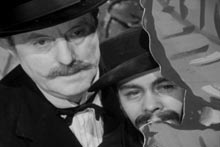
The film is nothing if not playful. Russell even goes so far as to cast Annette Robertson in drag as the diminutive absurdist French playwright Alfred Jarry, Rousseau’s first admirer and supporter. It also represents the first—but certainly not the last—of Russell’s films to take a shot at critics and the tastemakers of the world. His depiction of Jarry’s play attacking the powerful trendsetter Pere Ubu (Bryan Pringle, a Russell regular) and the delicate sensibilities of the Parisian elite is still a bit shocking, and serves as an interesting reminder of a time (not that long ago) when art was free to enrage and be “dangerous” in a way we see all too infrequently these days—both Jarry’s art and Russell’s.
The presentation of Rousseau as a complete innocent jives with what we know of the man, though the narration (voiced by Oliver Reed) points out at one point that there’s a degree of speculation afoot here since Rousseau wrote few letters and never kept a journal. His interior thoughts, as a result, are left largely to this concept of naivete and the viewer’s own imagination. That even his friends found Rousseau a figure of fun to be made sport of (safely assuming that Rousseau himself would never get the joke) is certainly accurate, as is the indifference and even outright hostility with which his paintings were originally met. For that matter, even Picasso (never shown except as a hat and a hand behind a Rousseau canvas) who recognized Rousseau’s genius early on can’t resist viewing the man himself as something of a joke. In this regard, Rousseau is very like a much later Russell subject, Anton Bruckner, in The Strange Affliction of Anton Bruckner (1990).
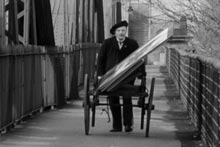
Whether or not Rousseau’s innocent, simple nature ever quite achieved the level of knockabout farce depicted is certainly debatable. Its effectiveness at capturing the charm of the man, his indefatigable belief in his own work, his unwarranted optimism in the face of critical and commercial indifference is not, however, open to question. For that matter, the fact that Russell loves this strange man and his work is never lost, nor is a degree of bitterness over the fact that such a man should suffer the kind of abuse and neglect that Rousseau did. This is perfectly summed up in the closing scene, which shows Rousseau wheeling one of his enormous canvases—which like all the others will be scorned or ignored—to be displayed, while the narrator comments, “His painting of The Dream is in the Museum of Modern Art in New York—valued at over a million dollars.”
Isadora Duncan: The Biggest Dancer in the World (1966). I’m going to go out on a limb here and say that this is perhaps my favorite of the BBC films. I won’t etch that in stone, because I suspect that some of that feeling is from the high I’m still feeling for finally really seeing the film. Oh, I saw it at least 25 years ago on PBS and many times since—always in battered 16mm prints. Seeing it in this set with remarkable picture quality was little short of a revelation. This is simply one gorgeous movie—and a triumph of making something wonderful out of very little indeed.
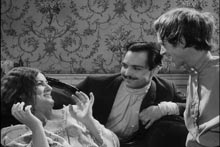
When Russell set out to make his film on the American dancer Isadora Duncan he was faced with what seemed an insurmountable problem. Karel Reisz was in the process of working on his big budget, big screen Duncan biopic Isadora (1968) with Vanessa Redgrave as the dancer, and his producers, Raymond and Robert Hakim, had effectively bought up the books on Isadora. This left Russell with no immediate source material that didn’t belong to someone else. It did, however, leave him with newspaper accounts, access to the writer Sewell Stokes (whose book, Isadora Duncan an Intimate Portrait, was owned by the Hakim Brothers) and his memories—and, best of all, his own imagination. The result was a film that captured the essence of Isadora in a way that Reisz’s film never even got near for all its expense and research and star power.
What made Russell’s Isadora work so completely was his refusal to cast a glamorous actress in the title role. The real Isadora Duncan was not attractive and she was far from svelte—in other words she looked nothing like Vanessa Redgrave. Isadora was a rather hefty lady whose magic came from within—from an innate charisma, a beguiling brashness, even vulgarity, and a positively superhuman belief in her own talent and her vision of the dance as a free-form means of artistic expression. To play her, Russell cast Vivian Pickles, an actress best know today for her portrayal of Bud Cort’s mother in Hal Ashby’s Harold and Maude (1971). Both the choice and Vivian Pickles were inspired. She—and the film—breathe life into this magnificently preposterous woman.
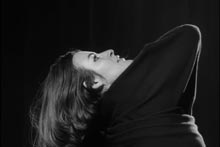
As filmmaking, Isadora is a textbook of getting a lot for a very little. Scenes are staged on often sparse sets or sets that have been effectively cluttered up via the BBC property department. Stock footage is pressed into service—often in humorous or satirical ways—when necessary, skillfully intercut by Russell and editor Michael Bradsell (beginning an association that has lasted to this day). The film also introduced the first occasion where Russell worked with cinematographer Dick Bush, who went on to work with him on many of Russell’s finest films.
In the end, however, its the feeling of the film as expressed through careful visual patterning (it’s not fer nuthin’ that Isadora’s dances inevitably conclude with her head thrust back), the power of sheer creativity and some of the most astonishing camerawork imaginable. All of this is put together with almost unbelievable precision in the editing. Just too look at the intercutting between Isadora onstage and her wigged-out Soviet husband, Sergei Yessenin (Alexei Jawdokimov), as he pilfers her dressing room, rapes her maid and goes on a rampage of espousing communist doctrine while pursued by the police is amazing. To see how intricately it fits together with Tchaikovsky’s Marche Slave takes it to a level of cinematic nirvana.
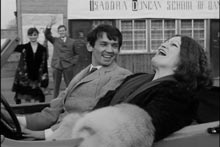
This may also be the first film ever (I can think of no earlier one) where a biographical filmmaker goes past the reality of his subject’s life to award them in death that thing they most desired in life. Whether it is or isn’t, the film’s final scene of Isadora—coming immediately after her freak accident death—shown in the form of her own idealization of herself realizing her ambition to dance with 500 schoolchildren to the “Ode to Joy” from Beethoven’s Ninth Symphony is one of the emotional glories of Russell’s work.
Dante’s Inferno (1967). The set skips over Russell’s next film, the charming documentary on French composer Georges Delerue (who scored French Dressing and would score Women in Love) Don’t Shoot the Composer (1966), and moves directly to his longest and most ambitious BBC film, Dante’s Inferno. This film on the Pre-Raphaelite painter and poet Dante Gabriel Rosetti brings back Oliver Reed. Reed portrays Rosetti from young manhood to his last days as a disillusioned and dissipated shell of himself and he does an amazing job of every aspect of the stages of the artist’s life.
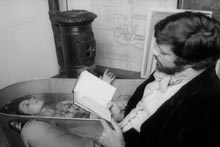
The film starts like a horror movie with a rotting corpse in its coffin being hauled out of the grave by torchlight so that a book of Rossetti’s poems can be retrieved from the grave. It’s a startling moment, but no more startling than the fact that it’s firmly grounded in fact. Rossetti did indeed bury his poems with the body of his wife, Elizabeth Siddal (the model for many of his paintings and for John Everett Millais’ painting Ophelia), who had committed suicide. It was an act of guilt over her death, and he was later persuaded to have her exhumed and the book recovered. Grisly and true—but in the world of Russell it serves a separate purpose in its depiction of art being snatched from the very jaws of death.
From there the film moves directly to a wild scene of the Pre-Raphaelites—including Rossetti—setting fire to paintings they disapprove of as examples of “academic” art, as is explained in a narration. Further explained is the Brotherhood’s own ideals of what art should be. The ideals are lofty—perhaps ridiculously so, because the Brotherhood itself can never really live up to their beliefs, but constantly debase them through their own excesses. It is probably the most unsparing—with the possible exceptions of Dance of the Seven Veils (1970) and Lisztomania (1975)—of all Russell’s portraits of artists. Throughout the film, the Pre-Raphaelites are depicted as a collection of buffoons, charlatans and hedonists, but the unflattering portrait of them is constantly undermined by their works. In other words, if these men are jokes, how did they produce these amazing works of art? Laugh at them all you wish, the paintings and the Rossetti poems we hear on the soundtrack tell a deeper, more mysterious story.
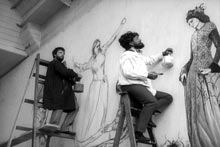
It is also not an unsympathetic portrait of Rosssetti and his “brothers.” By the end of the film—in a truly spectacular scene set to Gustav Holst’s “Saturn, the Bringer of Old Age” from The Planets, Russell shows us the torment of Rossetti and the price he, too, has to pay from his self-indulgences and unbridled egotism. This is underscored at the very end with Rossetti, a totally broken man, barely able to hobble down a hill that he capered up earlier in the film, while Holst’s “Neptune, the Mystic” plays on the soundtrack. The irony of the whole Pre-Raphaelite enterprise is then forcefully driven home by a calliope playing the 1920s song “I Want to Be Happy” over the ending credits, since happiness eluded all of them in their efforts.
Done in an astonishing mix of realism and fantasticated dream imagery—and with one of Russell’s most involved tapestries of music—Dante’s Inferno remains a boldly visionary work. It was ahead its time 41 years ago and it may still be so today.
Song of Summer (1968). Named more often than any of Russell’s films as his personal favorite, Song of Summer is an easy film to love—and to admire. I first saw this film when I was researching my 1984 book on Russell, Ken Russell’s Films, and I saw it under less than ideal circumstances—in a 16mm print on an editing machine at the Library of Congress. Worse, in those early home video days when so little was available, I had already sat through The Boy Friend (1971) and Savage Messiah (1972), running them on a 35mm editing machine on 20 minute reels while wearing the Library’s exceedingly uncomfortable WWII surplus headphones. (Research has changed for the better in the intervening years.) Even then, it was a startling, sweet, loving and strangely real film—and those were hardly the best circumstances.
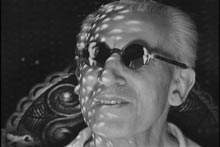
Song of Summer is a film about devotion, about giving—about giving far beyond any reasonable expectations. It can be viewed as a film of self-sacrifice—even of self-sacrifice that was unwarranted—but that’s unfair to the film and to the character of Eric Fenby, on whose memoir, Delius As I Knew Him, the film was based on. It tells the story of Eric Fenby (Christopher Gable), a young musician—and a staunch Catholic—who read of the tragedy of the composer Frederick Delius (Max Adrian in the performance of a lifetime). Though still having compositions in his head, Delius had gone blind and was completely paralyzed and unable to get those compositions on paper. Fenby offered his services—which were accepted—to act as amanuensis to the composer, getting much more than he bargained for.
The gentle and devout Fenby found himself up against the bitter, biting and self-proclaimed pagan that was also still inside Delius, alongside those compositions. Self-centered and arrogant, Delius’ had little notion of gratitude—or at least had no way of showing it. He railed at and abused the young man, dismissed as “no good” when he couldn’t take down music based entirely on Delius growling out “ter-ter-ter” sounds instead of notes, and generally made life miserable for him. Some of this changed when Delius’ wife, Jelka (a heartbreaking Maureen Pryor), urged Fenby to stand up to Delius, thereby earning his respect. Slowly—and never easily—Fenby became devoted to his frequently miserable master.
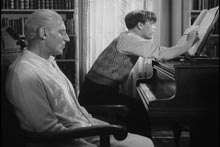
The film will surprise some viewers because it is one of Russell’s more restrained works. But it’s not forcibly restrained. It’s restrained by the material, which dictates its form (much in the way that the quietness of the moment dictates the simple approach to Twiggy singing “You Are My Lucky Star” in The Boy Friend). It’s also by no means humorless, nor is it emotionally restrained. Far from it. The relationship between Fenby and Delius is one of the most deeply felt in all Russell. And, as an aside, Max Adrian’s Delius is one of the most quotable—to the point of doing an impression—character in all Russell. Indeed, I once succumbed to the temptation of “doing” Adrian saying, “English music will never be any good till the get rid of Jesus,” in front of Russell. (This netted me a typically overstated Russell riposte—“Well, they got rid of Jesus and it still isn’t any good.” Serves me right.)
And that brings us to things about the set that aren’t so swell about this box set. On a minor level, there are some cuts that have been made to the films. The “Greek Sequence” (listed in the credits) from Isadora that was taken from Leni Riefenstahl’s Olympiad (1938) have been excised, presumably so as not to pony up for the copyright costs. (Oddly, one piece of this footage has been left in the “Liebestod” sequence. Overlooked? Who knows?) Similarly—and this was the case with an earlier release—the opening of Song of Summer is truncated to remove footage from the Laurel and Hardy film Way Out West (1937) that Fenby is shown playing music for in a silent cinema. (OK, so the talkie Way Out West wasn’t the best choice here to begin with.) These, however, are minor things and seem a pretty small price to pay for seeing these films in as near to pristine condition as possible. (For most people to see them at all!) But there’s something else.
The set was originally advertised as including Russell’s final—and ultra-rare—BBC film Dance of the Seven Veils: A Comic Strip in Seven Episodes on the Life of Richard Strauss (1970). The film is conspicuous by its absence—and a completely lack of explanation as to why. The why isn’t hard to imagine, though, because Dance of the Seven Veils was only officially show once—on its original showing in 1970. It resulted in such a furor of protests that it became a legendary scandal (see—art could still be “dangerous” in 1970!) and prompted the Strauss family to slap an embargo on the music, so that it could not be shown publicly. (It has, however, been featured—albeit on the sly—at film festivals on occasion, thanks to collectors who have secured prints.)
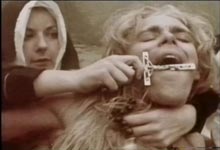
It had been hoped that the embargo (which ends in 2019, I think) had been lifted or didn’t apply in the United States. Actually, it had been hoped that this had just somehow slipped by, if it comes to that. Obviously, it hasn’t. And it’s a great pity.
It’s a great pity not only because it keeps an amazingly key piece of Russell’s filmography out of sight, but because the Strauss family overreacted in the first place. As part of Russell’s work, its value is almost beyond belief—the film plays like a 60 minute preview into everything that was to come. It offers invaluable insight into his thought process and how it would play out on the screen in the subsequent years. But more than this, Dance is so much more than the hatchet job the Strauss family have viewed it as that it needs to be seen for that reason alone.
This film does indeed depict Richard Strauss (Christopher Gable) as more than a little full of himself and in need of taking down. It also doesn’t gloss over his involvement with—or at least sucking up to the Nazis and Hitler—but really how could it? This is fact, but it’s not a wholly unsympathetic attack. First of all, while Russell makes mock of Strauss’s excesses, he keeps coming back to the quality of the music itself. He takes great delight in staging a scene where Strauss by the sheer force of his music overpowers and silences his detractors—and has admitted that he, as a frequent victim of critics and tastemakers, took great personal satisfaction with this.
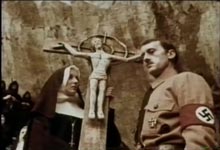
Moreover, the infamous scene where Strauss urges an orchestra to play louder and louder to drown out the screams of an elderly Jew (Otto Diamant) having a Star of David carved in his chest by Nazi thugs is not presented without conscience—without a sense that Strauss is painfully (look at Gable’s expressions) trying to keep himself from hearing and seeing what’s going on. (It’s the visual equivalent of a line in Derek Jarman’s Jubilee—“If the music’s loud enough we won’t hear the sound of the world falling apart around us.”) Similarly, he pays the complete price of becoming a doddering old man when Goebbels (Vladek Sheybal) forces him to write a letter of apology to Hitler, declaring his loyalty to the Nazi cause, following Stauss having ill-advisedly written a very different letter to his Jewish collaborator that fell into the Nazis’ hands. At that moment, Strauss betrays his art and himself. It’s grim and it’s damning, but it’s followed by a scene that can—and I think should—be read as Strauss being redeemed in part and reborn through his music as he conducts Also Sprach Zarathustra at the end of the film and rips off the mask (and baggage?) of old age and his shortcomings. As always, in Russell the art outlives and somehow outstrips the artist.
Now, if only the Strauss family could be made to see this reading of the film as more to the point than what so enraged them 38 years ago, the film might be made available to us to judge on its own merits. And, truth is, the BBC has enough material for another box set—for which it would be the crowning jewel.






Good to see you writing more about Russell, Ken (a warm up for something specific to come, I hope).
The set was delivered to me on Tuesday thanks to Amazon’s reliable pre-order system. I already knew about the omission of DANCE OF THE SEVEN VEILS thanks to the one early review that I could find.
I have not had a chance to watch everything in the set yet, but I have been pleased with what I have seen. Of course, I jumped immediately to ALWAYS ON SUNDAY, since it has heretofore been impossible to see. I was probably a bit more impressed then you, but I’m thinking of it in relation to a recent documentary I saw on Rousseau that accompanied a traveling exhibition of his paintings. I really wish that the National Gallery in DC had been able to accompany the exhibition with Russell’s film, as it really blows the other one out of the water. The staging of UBU ROI is a direct precursor to his theatrical presentation in ALICE IN RUSSIALAND. In ALWAYS, I especially liked the touch of having bourgeois audience members double as participants in what still remains the most anti-bourgeois play in 20th century theater.
The other point of real interest to me was the “Russell at Work” documentary. The footage of Russell on set filming ISADORA, as well as the sequences of editing with Michael Bradsell and of setting the music were fascinating. Better still was the fact that it included extensive footage of DIARY OF A NOBODY, a film that I had only previously encountered through still images. Another (apparently) great use of Bryan Pringle.
The copyright issues are confounding, not least of all because you can still hear The Kinks’ “You Really Got Me” playing in the party sequence of THE DEBUSSY FILM.
Also, it was nice to finally be able to understand some sequences of THE DEBUSSY FILM, since previously circulating copies (as you know) had rancid sound. THE DEBUSSY FILM looked great and really raised my opinion of it.
I hope to watch the rest of these this weekend. As you know, it is time for me to renew my immersion.
Of course, I jumped immediately to ALWAYS ON SUNDAY, since it has heretofore been impossible to see. I was probably a bit more impressed then you, but I’m thinking of it in relation to a recent documentary I saw on Rousseau that accompanied a traveling exhibition of his paintings.
I went straight for it, too, and for the same reason. And as I said, I’m not calling it minor yet — give me a while to live with it. (“For aesthetic appreciation always a little time” — Ruth Gordon in Harold and Maude.) Rousseau is probably my favorite painter and this may have made my desires for something truly magnificent too high. I may well be undervaluing not for what it is, but for what it isn’t. That’s not to say that I didn’t like it, because I did.
The footage from Diary of a Nobody was a huge treat and made me want to see the whole film, which has always been kind of low on my list of desires. I think this was because I’d never grasped its approach — and because I’d read the source book and was underwhelmed. It plays better — especially when it plays as a silent movie.
I’ve no idea how the Kinks song got by or why. Maybe the Kinks are more affordable? The whole rights issue business is hard to understand — broadcast rights and ancillary rights being two completely different things, for example.
One thing I wanted to get into and ran out of time to explore in this piece was the fact that Dante’s Inferno is also a very key work in that it is where Ken came face to face with the Lake District. Few things have had as much impact on his films.
Obtaining this DVD was like a religious experience for me. Having only heard about these films for years, to finally see them was astonishing. I’m still a little pissed that Dance of the Seven Veils wasn’t included. And except for a nice review in Film Comment, the release isn’t getting nearly as much publicity as a director of Russell’s stature deserves. So keep up the good work in getting the word out on this wonderful release.
For someone who thought that Russell’s real work began with WOMEN IN LOVE, this set is revelation. My favorite is also ISADORA DUNCAN, but I loved most if not all of the films included. Hopefully our customers will dig in as well…
And except for a nice review in Film Comment, the release isn’t getting nearly as much publicity as a director of Russell’s stature deserves. So keep up the good work in getting the word out on this wonderful release.
There was a lovely review on some DVD site, but I’ve lost the link to it. Justin may still have it, because it’s where he originally confirmed the lack of Dance of the Seven Veils — something that, galling as that is, has tended to overwhelm the importance of that which we did get!
For someone who thought that Russell’s real work began with WOMEN IN LOVE, this set is revelation.
While I wouldn’t make too strong a case for Billion Dollar Brain — though I’ve grown to like it and without it we probably wouldn’t have had Women in Love — Ken’s French Dressing is a terrific little movie very much in the New Wave tradition that was leading to the Richard Lester British Invasion style. In fact, French Dressing prefigures several things in A Hard Day’s Night, but it’s got this tremendous drawback of starring James Booth rather than the Beatles. Unfortunately, the film is almost never shown and I don’t see much chance of it hitting DVD any time soon.
My favorite is also ISADORA DUNCAN, but I loved most if not all of the films included. Hopefully our customers will dig in as well…
I hope they do. There is so much to see here and appreciate. Justin and I managed to run Isadora on a big screen last week and it was an absolute revelation to me, while Justin bemoaned the fact that there’s really no one doing anything like this in movies today — and this was for TV. He has a point.
Check this out as soon as I can. I’m interested to know what has become of Russell in the last twenty years. From the list of credits on IMDB it seems that he’s done mostly television work, but none of it seems availible.
Have you seen his later work? Can you give any guide on it?
Ken hasn’t made a proper feature since Whore in 1990. You really can’t count Mindbender — and he doesn’t. It was a misbegoten mess from the onset, was never released in the US and is pretty awful. The upside, I guess, might be that he and Terence Stamp became friends during the shoot. (I confess to liking it better than the Showtime TV film, Dogboys, if only because I can tell it’s a Ken Russell picture — or an attempt at one. I can’t say that about Dogboys, though I know Ken prefers the latter.)
The later work is hard to find. The Strange Affliction of Anton Bruckner and The Secret Life of Arnold Bax were at least run on Bravo. The more ambitious The Mystery of Dr. Martinu has never been shown in this country. All three are very worth seeing. His four part, four hour Lady Chatterley was brought out on DVD, but in compromised form. Even though there was a VHS set of it that retained the original music, the DVD replaces most, if not all, of the classical music with a much more generic track. This especially hurts a wonderful dream sequence that was originally set to “Saturn, the Bringer of Old Age” from Holst’s The Planets. The film itself is uneven with all the best material in parts one and four.
A lot of the smaller films — Alice in Russialand, Road to Mandalay, Treasure Island — are fun for the hardcore Russellite, but hardly essential. The only of his “backyard” movies — ones made by himself, his wife Lisi, and his friends on digital video — available is (or was, it might be OOP) The Fall of the Louse of Usher. I like large chunks of this very odd, often daring little movie, but I would never recommend it to anyone who isn’t a fan with a solid grounding in the essential works. It is a drastically altered version of an old screenplay that was once almost made with Roger Daltrey and Twiggy. When that fell through, Ken turned it into a very jokey fever dream of a digital movie. Some of the gags just play too long, all of it’s very broad, and he never seems to have worked out a proper ending. That said, there are some remarkable and even remarkably disturbing images in it.
A lot of this stuff is available from collectors, but not commercially — at least at this time. There’s a chance that his latest, Bodica, which was made in connection with the Univ. of Wales (if memory serves) where he teaches, will play on The South Bank Show, which means it might make it Bravo. (I don’t even know if Bravo still runs The South Bank Show, though.)
And you can always go to the Comedy Box website and see his A Kitten for Hitler, a deliberately bad taste trailer for a non-existent movie of that title.
Thanks very much. You are genuine encyclopedia.
My god that was in bad taste–I loved it. A Kitten for Hitler is going to be the name of the nonprofit charity orginization I’m currently putting together.
Has he not been able to make a major feature in twenty years because he can’t get funding?
Has he not been able to make a major feature in twenty years because he can’t get funding?
That may be a simplification, but it’s pretty much the truth. Of course, now he’s 81 and that’s an additional factor.